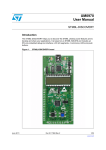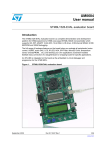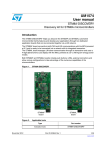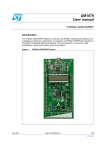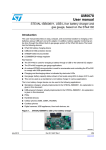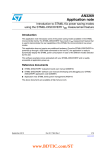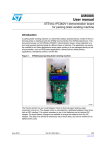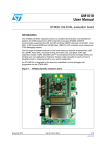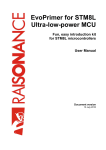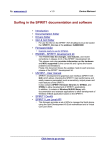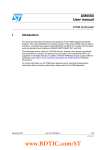Download UM0970 User Manual
Transcript
UM0970 User Manual STM8L-DISCOVERY Introduction The STM8L-DISCOVERY helps you to discover the STM8L ultralow power features and to develop and share your applications. It is based on an STM8L152C6T6 and includes an STLink embedded debug tool interface, LCD (24 segments, 4 commons), LEDs and push buttons. Figure 1. September 2010 STM8L-DISCOVERY board Doc ID 17693 Rev 1 1/29 www.st.com Contents UM0970 Contents 1 Quick start . . . . . . . . . . . . . . . . . . . . . . . . . . . . . . . . . . . . . . . . . . . . . . . . . 3 1.1 Getting started . . . . . . . . . . . . . . . . . . . . . . . . . . . . . . . . . . . . . . . . . . . . . . 3 1.2 System requirements . . . . . . . . . . . . . . . . . . . . . . . . . . . . . . . . . . . . . . . . . 3 1.3 Development toolchain . . . . . . . . . . . . . . . . . . . . . . . . . . . . . . . . . . . . . . . . 4 1.4 Demonstration software . . . . . . . . . . . . . . . . . . . . . . . . . . . . . . . . . . . . . . . 4 1.5 Order code . . . . . . . . . . . . . . . . . . . . . . . . . . . . . . . . . . . . . . . . . . . . . . . . . 4 2 Features . . . . . . . . . . . . . . . . . . . . . . . . . . . . . . . . . . . . . . . . . . . . . . . . . . . 5 3 Hardware and layout . . . . . . . . . . . . . . . . . . . . . . . . . . . . . . . . . . . . . . . . . 6 3.1 STM8L152C6T6 microcontroller . . . . . . . . . . . . . . . . . . . . . . . . . . . . . . . . 9 3.2 Embedded ST-Link . . . . . . . . . . . . . . . . . . . . . . . . . . . . . . . . . . . . . . . . . . 11 3.2.1 Using the ST-Link to program/debug the STM8L on board . . . . . . . . . . 12 3.2.2 Using the ST-Link to program/debug an external STM8L application . . 12 3.3 Power supply and power selection . . . . . . . . . . . . . . . . . . . . . . . . . . . . . . 13 3.4 LEDs . . . . . . . . . . . . . . . . . . . . . . . . . . . . . . . . . . . . . . . . . . . . . . . . . . . . 13 3.5 Push buttons . . . . . . . . . . . . . . . . . . . . . . . . . . . . . . . . . . . . . . . . . . . . . . 13 3.6 Built-in IDD measurement circuit . . . . . . . . . . . . . . . . . . . . . . . . . . . . . . . 14 3.6.1 Run mode . . . . . . . . . . . . . . . . . . . . . . . . . . . . . . . . . . . . . . . . . . . . . . . 14 3.6.2 Low power mode . . . . . . . . . . . . . . . . . . . . . . . . . . . . . . . . . . . . . . . . . . 14 3.6.3 Low power mode IDD measurement principle . . . . . . . . . . . . . . . . . . . . 15 3.6.4 Ibias current measurement procedure . . . . . . . . . . . . . . . . . . . . . . . . . . 16 3.7 Solder bridges . . . . . . . . . . . . . . . . . . . . . . . . . . . . . . . . . . . . . . . . . . . . . 16 3.8 LCD (24 segments, 4 commons) . . . . . . . . . . . . . . . . . . . . . . . . . . . . . . . 17 4 Extension connection . . . . . . . . . . . . . . . . . . . . . . . . . . . . . . . . . . . . . . . 19 5 Electrical schematics . . . . . . . . . . . . . . . . . . . . . . . . . . . . . . . . . . . . . . . 23 6 Revision history . . . . . . . . . . . . . . . . . . . . . . . . . . . . . . . . . . . . . . . . . . . 28 2/29 Doc ID 17693 Rev 1 UM0970 1 Quick start Quick start The STM8L-DISCOVERY is a low-cost and easy-to-use development kit to quickly evaluate and start a development with an STM8L ultralow power microcontroller. Before installing and using the product, please accept the Evaluation Product License Agreement from www.st.com/stm8l-discovery. For more information on the STM8L-DISCOVERY and for demonstration software visit www.st.com/stm8l-discovery. 1.1 Getting started 1. Check jumper positions on the board, JP1 and CN3 ON (Discovery selected). 2. Connect the STM8L-DISCOVERY board to a PC with a USB cable to power the board. Red LED LD2 (PWR) then lights up. 3. Function 1 is executed and each click on user button B2 changes the executed function as described in Table 1. Table 1. Functions Function LED LD3/4 Bars Value displayed 1 Blink STM8L VDD voltage measured 2 Off STM8L consumption measured in Run mode 3 Off STM8L consumption measured in Low power mode, LCD on 4 Off STM8L consumption measured in Low power mode, LCD off 5 Off STM8L consumption measured in Halt mode, LCD off To study or modify the DISCOVER project related to this demo, visit www.st.com/stm8ldiscovery and follow the tutorial. Discover the STM8L features, download and execute programs proposed in the list of projects. This site also contains examples from which you can develop your own applications. 1.2 System requirements ● Windows PC (2000, XP, Vista) ● A/Mini-B USB cable Doc ID 17693 Rev 1 3/29 Quick start 1.3 1.4 UM0970 Development toolchain ● IAR, Embedded Workbench® for STM8 ● STMicroelectronics, ST Visual Develop (STVD) Demonstration software Demonstration software is preloaded in the board's Flash memory. This demonstration uses the built-in IDD measurement feature of the STM8L-DISCOVERY to automatically measure and display on the LCD the consumption of the MCU in run and low power modes. The latest versions of this demonstration source code and associated documentation can be downloaded from www.st.com/stm8l-discovery. 1.5 Order code To order the STM8L ultralow power Discovery, use the order code STM8L-DISCOVERY. 4/29 Doc ID 17693 Rev 1 UM0970 2 Features Features The STM8L-DISCOVERY offers the following features: ● STM8L152C6T6 microcontroller, 32 KB Flash, 2 KB RAM, 1 KB EEPROM in 48-pin LQFP ● On-board ST-Link with selection mode switch to use the kit as a stand-alone ST-Link (with SWIM connector for programming and debugging) ● Two red LEDs; LD1 for USB communication, LD2 for 3.3 V power on ● Designed to be powered by USB or an external supply of 5 V or 3.3 V ● Can supply target application with 5 volts and 3 volts ● Two user LEDs, LD3 and LD4 (green and blue) ● Two push buttons (User and Reset) ● IDD current measurement ● LCD 28-pin DIP (24 segments, 4 commons) ● Extension header for all QFP48 I/Os for quick connection to prototyping board for easy probing Doc ID 17693 Rev 1 5/29 Hardware and layout 3 UM0970 Hardware and layout The STM8L-DISCOVERY is designed around the STM8L152C6T6 microcontroller in a 48pin LQFP package. Figure 2 illustrates the connections between the STM8L152C6T6 and its peripherals (STLink, push button, LED, LCD and connectors). Figure 3 and Figure 4 help you to locate these features on the STM8L-DISCOVERY. Figure 2. Hardware block diagram Mini USB SWIM Embedded ST-LINK STM8L152C6T6 I/O RESET Green LED LD3 B1 RST Blue LED LD4 B2 USER IDD measurement P2 Header LCD (24 segments, 4 commons) 6/29 Doc ID 17693 Rev 1 P3 Header I/O P1 Header I/O UM0970 Figure 3. Hardware and layout Top layout D2 diode D1 diode LD2 power LD1 COM ST-Link CN2 SWIM connector CN3 ST-Link/Discovery selector IDD module LCD 24 segments JP1 +5V power supply input IDD measurement +3.3V power supply input SB1,2 X2 crystal STM8L152C6T6 B1 Reset button B2 User button LD4 LED blue LD3 LED green Doc ID 17693 Rev 1 7/29 Hardware and layout Figure 4. UM0970 Bottom layout SB3,5,7,9 PRG-32 (RESERVED) SB4,6,8,10 DEFAULT SB11,12,14 IDD_Measurement P2 connector P1 connector JP1 IDD SB13,15 X3 crystal SB17 B2-USER SB16 B1-RESET P3 connector 8/29 Doc ID 17693 Rev 1 UM0970 3.1 Hardware and layout STM8L152C6T6 microcontroller This 8-bit ultralow power MCU has 32 KB Flash, 2 KB RAM, 1 KB data EEPROM, RTC, LCD, timers, USART, I2C, SPI, ADC, DAC and comparators. Figure 5. STM8L152C6T6 package The STM8L152C6T6 8-bit microcontroller offers: 32 Kbytes of Flash memory 2 Kbytes RAM 1 Kbytes EEPROM LQFP48 7 x 7 mm This device provides the following benefits: ● Ultralow power proprietary 130 nm technology: Speed and power consumption independent of MCU power supply, Ultralow leakage ● Ultralow power design (clock gating, low-power Flash with power-off capability): Reduced overall Run and Wait mode current consumption by turning off clocks of unused peripherals or Flash ● Sub 1 µA hardware RTC and AWU system unit: Ultralow power modes for applications requesting regular wake up ● Range of Low power modes (up to 4): Suitable for many applications from complete switch off to continuous monitoring at ultralow frequency ● Advanced and flexible clock system (multiple internal and external clock sources): Switch and adjust frequency and clock sources on the fly depending on application needs ● Direct memory access on board (4-channel DMA): Autonomy for peripherals, independent from core; can switch off Flash memory and CPU (large current consumption contributors) while keeping peripherals active ● Ultralow power and ultrasafe reset system POR/PDR; additional optional activation BOR: Integrated safety and security for application ● Ultrafast wakeup from lowest Low power mode (4 µs): Fast switching from Static and Dynamic power modes ● Analog functional down to 1.8 V, programming down to 1.65 V: Full functionality over the complete VDD range For more information see the STM8L152C6T6 datasheet (Doc ID 15962) on the ST website. Doc ID 17693 Rev 1 9/29 Hardware and layout Figure 6. 10/29 UM0970 STM8L152C6T6 block diagram Doc ID 17693 Rev 1 UM0970 3.2 Hardware and layout Embedded ST-Link The ST-Link programming and debugging tool is integrated on the STM8L-DISCOVERY. The embedded ST-Link can be used in 2 different ways according to the jumper states (see Table 2): ● to program/debug the MCU on board, ● to program/debug an MCU in an external application board using a cable connected to SWIM connector CN2. For information about debugging and programming features refer to ST-Link UM0627. Note: UM0627 contains information about all the ST-Link features. Usage in this situation is restricted to STM8 devices and SWIM support. Figure 7. Typical configuration Hardware requirements: - USB cable type A to mini-B - Computer with Windows 2000, XP or Vista OS Development toolchain: - IAR, Embedded Workbench® for STM8L - STMicroelectronics, ST Visual Develop (STVD) Table 2. Jumper states Jumper state Description Both CN3 jumpers ON ST-Link functions enabled for on board programming (default) Both CN3 jumpers OFF ST-Link functions enabled for external application through CN2 connector (SWIM supported). Doc ID 17693 Rev 1 11/29 Hardware and layout 3.2.1 UM0970 Using the ST-Link to program/debug the STM8L on board To program the STM8L on board, simply plug in the two jumpers on CN3, as shown in Figure 8 in red, but do not use the CN2 connector as that could disturb communication with the STM8L152C6T6 of the STM8L-DISCOVERY. Figure 8. STM8L-DISCOVERY connections image Jumpers on CN3 3.2.2 Using the ST-Link to program/debug an external STM8L application It is very easy to use the ST-Link to program the STM8L on an external application. Simply remove the 2 jumpers from CN3 as shown in Figure 9, and connect your application to the CN2 debug connector according to Table 3. Table 3. Debug connector CN2 (SWIM) Pin 12/29 CN2 Designation 1 VDD_TARGET VDD from application 2 SWIM SWIM data input/output 3 GND Ground 4 SWIM_RST SWIM reset Doc ID 17693 Rev 1 UM0970 Hardware and layout Figure 9. ST-Link connections image No jumpers on CN3 3.3 Power supply and power selection The power supply is provided either by the host PC through the USB cable, or by external power supply (5 V or 3.3 V). The D1 and D2 protection diodes allow the 5V and 3V3 pins to be used independently as input or output power supplies (see Figure 3). The 5V and 3V3 pins can be used as an output power supply for use by an application board connected on pin headers (P1 to P3). In such a case, the 3V3 pin provides only a 3V power supply and the power consumption must be lower than 100 mA. The 5V and 3V3 pins can also be used as an input power supply for the board when the USB connector is not connected to the PC. 3.4 3.5 LEDs ● LD1 COM: Red LED indicates communication in progress between PC and ST-Link. ● LD2 PWR: Red LED indicates that the board is powered. ● LD3 PE7: Green LED is a user LED connected to the I/O PE7 of the STM8L152C6T6. ● LD4 PC7: Blue LED is a user LED connected to the I/O PC7 of the STM8L152C6T6. Push buttons ● B1 RST: Push button is used to RESET the STM8L152C6T6. ● B2 USER: User push button connected to the I/O PC1 of the STM8L152C6T6. Doc ID 17693 Rev 1 13/29 Hardware and layout 3.6 UM0970 Built-in IDD measurement circuit The STM8L-DISCOVERY built-in IDD measurement circuit allows the consumption of the STM8L152C6T6 to be measured and displayed on the LCD Glass while the MCU is in Run or Low power saving modes. Note: ● JP1 in ON position: STM8L152C6T6 is powered through IDD measurement circuit (default). ● JP1 in OFF position: STM8L152C6T6 is powered directly by +3V3, IDD measurement circuit is bypassed. When jumper JP1 is removed the current consumption of the STM8L152C6T6 can be measured by connecting an ammeter between jumper JP1 pin 1 and pin 2. For IDD measurement by the MCU itself, the circuit below is implemented on the STM8LDISCOVERY. Solder bridges SB11, SB12 and SB14 must be closed and a jumper must be plugged between JP1 pin 2 and pin 3. Figure 10. STM8L-DISCOVERY IDD measurement circuit IDD on 3 I/O O/I C GND VCC R18 2 10K 5 C11 1uF +3V3 74H1G66STR D T1 STT5PF20V +3V3 5 +3V3 3 2 3 G 0 T2 3 4 S PF0 R17 SB11 4 IDD_Measurement +3V3 5 1 2 6 STT5PF20V G 2K(1%) U6 5 1 2 6 R21 2(1%) 4 R20 1 4 3 2 4 +3V3 U4 MAX9938FEUK+ S 5 U7 74LX1G04CTR 1 2 3 4 5 6 7 8 U3 Q12 VCC Q13 Q10 Q14 Q8 Q6 Q9 Q5 CLR Q7 CI Q4 CO GND CO D JP1 1 3 1 off 2 VDD_MCU C12 100nF 16 15 14 13 12 11 10 9 PE6 SB12 +3V3 R26 10K PC4 SB14 C13 1nF M74HC4060TTR R22 15K IDD_WAKEUP R19 47K IDD_CNT_EN R23 30K Oscillator frequency 30KHz 3.6.1 Run mode In Run mode, IDD current is measured using the operational amplifier MAX9938FEUK+ (U4) connected to the 2Ω shunt resistor (R20). In this case IDD_CNT_EN remains high during measurement, so R21 remains in short-circuit during the measurement because of transitor T1 which remains ON permanently. The jumper JP1 must be connected between pins 2 and 3 of JP1. 3.6.2 Low power mode In Low power modes (Halt or Active halt), the operational amplifier MAX9938FEUK+ (U4) is connected to the 2KΩ shunt resistor (R21), controlled by the analogue switch STT5PF20V (T1). In this case the counter 74HC4060 (U3) enabled by IDD_CNT_EN manages the measurement timing according to Figure 11. 14/29 Doc ID 17693 Rev 1 UM0970 3.6.3 Hardware and layout Low power mode IDD measurement principle The principle used to measure a current when the STM8L152C6T6 is in Low power mode is: 1. Configure ADC to measure voltage on the IDD_Measurement pin. 2. Configure PE6 to serve as wakeup pin. 3. Enter Low power mode after setting IDD_CNT_EN (PC4) signal low. 4. IDD_WAKEUP rising edge wakes up the MCU after around 300 ms. 5. Start ADC conversion as soon as possible after wakeup in order to measure the voltage corresponding to Low power mode on capacitor C11. 6. Reset the counter by programming IDD_CNT_EN high (in less than 70 ms after the wakeup) to avoid the R21 2 KΩ resistor being connected later in Run mode. The measurement timing is given in Figure 11. In Low power modes, the 2 KΩ resistor is connected when T1 goes off after entering Low power mode. Q13 output of the counter allows connection of the 2 KΩ resistor when the current IDD becomes very low. Figure 11 shows how the counter and T1 ensure that, 150 ms after IDD_CNT_EN falling edge, the shunt resistor R21 is connected between VDD_MCU and the power supply in order to reduce the measurement range to 30 uA full scale. Then after another 150 ms for current stabilization, R21 is shorted, the IDD measurement is stored in C11, and the MCU is woken up. After wakeup the MCU can measure the IDD current corresponding to the Low power mode stored in C11. Figure 11. STM8L-DISCOVERY IDD Low power mode measurement timing diagram The Low power mode measurement procedure can be used in Halt or Active halt mode if the IDD current does not exceed 30 uA, otherwise the IDD measurement procedure in Run mode should be used up to 30 mA. Doc ID 17693 Rev 1 15/29 Hardware and layout 3.6.4 UM0970 Ibias current measurement procedure In Low power mode the bias current of operational amplifier input (U4 pin 4) is not negligible compared to IDD current (typical Ibias is ~240 nA). To obtain a reliable STM8L152 IDD measurement it is mandatory to subtract the bias current from the IDD low power measurement since this current is not sinked by the MCU. Ibias is measured during production test and stored in the MCU EPROM. The demonstration software, Discover, uses this value to display the correct IDD. The Ibias measurement procedure is part of the demonstration software and can be launched if required. The procedure for Ibias measurement (implemented in the Demo) is: 1. Power off the board (disconnect the USB cable). 2. Set jumper JP1 to OFF position (pins 1 and 2). 3. Push down B2 (USER button), power on the board from the USB. 4. Wait at least 1 second before releasing B2, the LCD displays the Ibias measurement. 5. Power off the board (disconnect the USB cable). 6. Set jumper JP1 to ON position (pins 2 and 3). The Ibias value is now stored. The bias current is then subtracted from the IDD measurement performed in Low power mode. 3.7 Solder bridges Table 4. Solder bridge Bridge State(1) Description Off PA2, PA3 are disconnected from P1 X2, C19, C20 and R24 provide a clock as shown in schematics On PA2, PA3 are connected to P1 (X2, C19, C20, R24 must not be fitted) SB3,5,7,9 (DEFAULT) On Reserved, do not modify SB4,6,8,10 (PRG-32) Off Reserved, do not modify Off PFO, PE6, PC4 are available and IDD module cannot be used JP1 must be set to OFF On PFO, PE6, PC4 are used by IDD module JP1 must be set to ON SB13,15 (X3 crystal) Off PC5, PC6 are only connected to P2 (but do not remove X3, C21, C23, R27) On PC5, PC6 are connected to P2. X3, C21, C23 and R27 provide 32 KHz clock SB16 (B1-RESET) Off PA1/RESET signal is only connected to P1 On PA1/RESET signal is used by ST_LINK as SWIM_RST and also connected to P1 SB17 (B2-USER) Off PC1 is only connected to P2 On PC1 is connected to P2 and push button B2 for user SB1,2 (X2 crystal) SB11,12,14 (IDD_Measurement) 1. Default state is in bold type. 16/29 Doc ID 17693 Rev 1 UM0970 3.8 Hardware and layout LCD (24 segments, 4 commons) This LCD allows the STM8L152C6T6 to display any information on six 14-segment digits and 4 BARs, using all COMs. (See the LCD segment mapping in Figure 12 and pin connections in Table 5.) Note: This LCD also supports six 8-segment digits by only using COM0 and COM1. This configuration allows COM2 and COM3 to be used as I/O ports. In this case the 2 LCD pins must not be plugged into the LCD socket. To proceed with this configuration, remove the LCD carefully, slightly open the COM2 and COM3 pins (pin 13 and pin 14) of the LCD, then replug it in the socket. Characteristics overview: Note: ● 24 segments and 4 commons ● Drive method: multiplexed 1/4 duty, 1/3 bias ● Operating voltage: 3 V ● Operating temperature: 0 to 50°C ● Connector: 28-pin DIL 2.54 mm pitch When the LCD is plugged, all I/O ports listed in Table 5 are unavailable. To use one of these as I/O, you must remove the LCD. Figure 12. LCD segment mapping Doc ID 17693 Rev 1 17/29 Hardware and layout Table 5. UM0970 LCD connections STM8L152C6T6 Pin name 18/29 LCD Pin COM3 COM2 COM1 COM0 PA7_LCDSEG0 1 1N 1P 1D 1E PE0_LCDSEG1 2 1DP 1COLON 1C 1M PE1_LCDSEG2 3 2N 2P 2D 2E PE2_LCDSEG3 4 2DP 2COLON 2C 2M PE3_LCDSEG4 5 3N 3P 3D 3E PE4_LCDSEG5 6 3DP 3COLON 3C 3M PE5_LCDSEG6 7 4N 4P 4D 4E PD0_LCDSEG7 8 4DP 4COLON 4C 4M PD2_LCDSEG8 9 5N 5P 5D 5E PD3_LCDSEG9 10 BAR2 BAR3 5C 5M PB0_LCDSEG10 11 6N 6P 6D 6E PB1_LCDSEG11 12 BAR0 BAR1 6C 6M PD1_LCDCOM3 13 COM3 PA6_LCDCOM2 14 PA5_LCDCOM1 15 PA4_LCDCOM0 16 PB2_LCDSEG12 17 6J 6K 6A 6B PB3_LCDSEG13 18 6H 6Q 6F 6G PB4_LCDSEG14 19 5J 5K 5A 5B PB5_LCDSEG15 20 5H 5Q 5F 5G PB6_LCDSEG16 21 4J 4K 4A 4B PB7_LCDSEG17 22 4H 4Q 4F 4G PD4_LCDSEG18 23 3J 3K 3A 3B PD5_LCDSEG19 24 3H 3Q 3F 3G PD6_LCDSEG20 25 2J 2K 2A 2B PD7_LCDSEG21 26 2H 2Q 2F 2G PC2_LCDSEG22 27 1J 1K 1A 1B PC3_LCDSEG23 28 1H 1Q 1F 1G COM2 COM1 COM0 Doc ID 17693 Rev 1 Extension connection 4 UM0970 Extension connection Male headers P1, P2 and P3 can connect the STM8L-DISCOVERY to a standard prototyping/wrapping board. All GPI/Os of STM8L152C6T6 are available on it. P1, P2 and P3 can also be probed by an oscilloscope, logical analyzer or voltmeter. P1 pinout Pin number Pin number (P1) (STM8L) 1 Main function Alternate function LCD (U5) 3.3 V board power supplied or supply external application when USB connected +3V3 1 PA0 3 9/40 GND 4 2 PA1 I/O Reset NRST/PA1(1) 5 3 PA2 I/O Port A2 PA2/OSC_IN/ [USART1_TX](3)/ [SPI1_MISO] (3) 6 4 PA3 I/O Port A3 PA3/OSC_OUT/ [USART1 _RX](3)/ [SPI1_MOSI](3) I/O Port A4 PA4/TIM2_BKIN/ LCD_COM0(2)/ ADC1_IN2/ COMP1_INP LCD_COM0 I/O Port A5 PA5/TIM3_BKIN/ LCD_COM1(2)/ ADC1_IN1/ COMP1_INP LCD_COM1 LCD_COM2 8 5 6 PA4 PA5 I/O Port A0 PA0/[USART1_CK](3)/ SWIM/BEEP/ IR_TIM (7) 2 7 19/29 Board pin name Type Table 6. Ground 9 7 PA6 I/O Port A6 PA6/[ADC1_TRIG](3)/ LCD_COM2(2)/ ADC1_IN0/ COMP1_INP 10 8 PA7 I/O Port A7 PA7/ LCD_SEG0(2)(4) LCD_SEG0 11 14 PE0 I/O Port E0 PE0(4)/ LCD_SEG1(2) LCD_SEG1 12 15 PE1 I/O Port E1 PE1/TIM1_CH2N / LCD_SEG2(2) LCD_SEG2 13 16 PE2 I/O Port E2 PE2/TIM1_CH3N / LCD_SEG3(2) LCD_SEG3 14 17 PE3 I/O Port E3 PE3/LCD_SEG4(2) LCD_SEG4 15 18 PE4 I/O Port E4 PE4/LCD_SEG5(2) LCD_SEG5 Doc ID 17693 Rev 1 UM0970 Extension connection Pin number Pin number (P1) (STM8L) 16 17 19 20 Board pin name PE5 PD0 18 21 PD1 19 9/40 GND Table 7. Type P1 pinout (continued) Main function Alternate function I/O Port E5 LCD_SEG6 I/O Port D0 PD0/TIM3_CH2/ [ADC1_TRIG](3)/ LCD_SEG7(2)/ ADC1_IN2 2/ COMP2_INP/ COMP1_INP LCD_SEG7 I/O Port D1 PD1/TIM3_TRIG/ LCD_COM3(2)/ ADC1_IN21/ COMP2_INP/ COMP1_INP LCD_COM3 Ground P2 pinout Pin number Pin number (P2) (STM8L) Pin name 1 +5V 2 NC Main function Alternate function 9/40 GND 4 48 PE7 I/O Port E7 PE7/LCD_SEG27(2) 5 47 PE6 I/O Port E6 PE6/LCD_SEG26(2)/ PVD_IN Ground 6 46 PC7 I/O Port C7 PC7/LCD_SEG25(2)/ ADC1_IN3/ COMP2_INM/ COMP1_INP 7 45 PC6 I/O Port C6 PC6/OSC32_OUT/ [SPI1_SCK](3)/ [USART1_RX](3) 8 44 PC5 I/O Port C5 PC5/OSC32_IN / [SPI1_NSS](3)/ [USART1_TX](3) I/O Port C4 PC4/[USART1_CK](3)/ I2C1_SMB/CCO/ LCD_SEG24(2)/ ADC1_IN4/COMP2_INM/ COMP1_INP 43 PC4 LCD (U5) 5 Volts board power supplied or supply external application when USB connected 3 9 LCD (U5) PE5/LCD_SEG6(2)/ ADC1_IN23/ COMP2_INP/ COMP1_INP Type Table 6. Doc ID 17693 Rev 1 20/29 UM0970 Extension connection P2 pinout (continued) Pin number Pin number (P2) (STM8L) 10 42 Pin name PC3 Type Table 7. Main function Alternate function LCD (U5) I/O Port C3 PC3/[USART1_TX](3)/ LCD_SEG23(2)/ ADC1_IN5/ COMP1_INP/ COMP2_INM LCD_SEG23 LCD_SEG22 11 41 PC2 I/O Port C2 PC2/[USART1_RX](3)/ LCD_SEG22/ ADC1_IN6/ COMP1_INP/ VREF_OUT 12 38 PC1 I/O Port C1 PC1(4)/I2C1_SCL 13 37 PC0 I/O Port C0 PC0(4)/I2C1_SDA I/O Port D7 PD7/TIM1_CH1N / LCD_SEG21(2)/ ADC1_IN7/ RTC_ALARM/ VREF_OUT/ COMP1_INP LCD_SEG21 I/O Port D6 PD6/TIM1_BKIN / LCD_SEG20(2)/ ADC1_IN8/ RTC_CALIB/ VREF_OUT/ COMP1_INP LCD_SEG20 I/O Port D5 PD5/TIM1_CH3 / LCD_SEG19(2)/ ADC1_IN9/ COMP1_INP LCD_SEG19 LCD_SEG18 14 15 16 36 35 34 PD7 PD6 PD5 17 33 PD4 I/O Port D4 PD4/TIM1_CH2 / LCD_SEG18(2)/ ADC1_IN10/ COMP1_INP 18 32 PF0 I/O Port F0 PF0/ADC1_IN24/ DAC_OUT 19 9/40 GND Doc ID 17693 Rev 1 Ground 21/29 Extension connection P3 pinout Pin number Pin number (P3) (STM8L) 1 2 3 4 5 6 7 8 9 10 22/29 22 23 24 25 26 27 28 29 30 31 Pin name PD2 PD3 PB0 PB1 PB2 PB3 PB4 PB5 PB6 PB7 Type Table 8. UM0970 Main function Alternate function LCD (U5) I/O Port D2 PD2/TIM1_CH1 / LCD_SEG8(2)/ ADC1_IN20/ COMP1_INP LCD_SEG8 I/O Port D3 PD3/ TIM1_TRIG/ LCD_SEG9(2)/ ADC1_IN1 9/ COMP1_INP LCD_SEG9 I/O Port B0 PB0/TIM2_CH1/ LCD_SEG10(2)/ ADC1_IN18/ COMP1_INP LCD_SEG10 I/O Port B1 PB1/TIM3_CH1/ LCD_SEG11(2)/ ADC1_IN17/ COMP1_INP LCD_SEG11 I/O Port B2 PB2/ TIM2_CH2/ LCD_SEG12(2)/ ADC1_IN16/ COMP1_INP LCD_SEG12 I/O Port B3 PB3/TIM2_TRIG/ LCD_SEG13(2)/ ADC1_IN15/ COMP1_INP LCD_SEG13 I/O Port B4 PB4/[SPI1_NSS](3)/ LCD_SEG14(2)/ ADC1_IN14/ COMP1_INP LCD_SEG14 I/O Port B5 PB5/[SPI1_SCK](3)/ LCD_SEG15(2)/ ADC1_IN13/ COMP1_INP LCD_SEG15 I/O Port B6 PB6/[SPI1_MOSI](3)/ LCD_SEG16(2)/ ADC1_IN12/ COMP1_INP LCD_SEG16 I/O Port B7 PB7/[SPI1_MISO](3)/ LCD_SEG17(2)/ ADC1_IN11/ COMP1_INP LCD_SEG17 Doc ID 17693 Rev 1 Electrical schematics Electrical schematics 23/29 5 Figure 13. STM8L-DISCOVERY IDD_measurement.SchDoc U_Power ST_LINK.SCHDOC U_ST_LINK P2 IDD_CNT_EN IDD_Measurement IDD_WAKEUP IDD_CNT_EN IDD_Measurement IDD_WAKEUP RESET# ST_LINK_SWIM EXT_5V EXT_3V3 MCU.SchDoc U_MCU Doc ID 17693 Rev 1 PA[0..7] PB[0..7] PC[0..7] PD[0..7] PE[0..7] PF0 RESET# ST_LINK_SWIM P1 1 2 3 4 5 6 7 8 9 10 11 12 13 14 15 16 17 18 19 Header 19 EXT_3V3 PA0 PA1 RST PA2 PA3 PA4 PA5 PA6 PA7 PE0 PE1 PE2 PE3 PE4 PE5 PD0 PD1 IDD_CNT_EN IDD_Measurement IDD_WAKEUP EXT_5V PE7 PE6 PC7 PC6 PC5 PC4 PC3 PC2 PC1 PC0 PD7 PD6 PD5 PD4 PF0 GH08172_buttons.SchDoc U_Power PA[0..7] PB[0..7] PC[0..7] PD[0..7] PE[0..7] PF0 RESET# ST_LINK_SWIM RESET# ST_LINK_SWIM EXT_5V EXT_3V3 IDD_CNT_EN IDD_Measurement IDD_WAKEUP PC3_LCDSEG23 PC2_LCDSEG22 PD7_LCDSEG21 PD6_LCDSEG20 PD5_LCDSEG19 PD4_LCDSEG18 PB7_LCDSEG17 PB6_LCDSEG16 PB5_LCDSEG15 PB4_LCDSEG14 PB3_LCDSEG13 PB2_LCDSEG12 PB1_LCDSEG11 PB0_LCDSEG10 PD3_LCDSEG9 PD2_LCDSEG8 PD0_LCDSEG7 PE5_LCDSEG6 PE4_LCDSEG5 PE3_LCDSEG4 PE2_LCDSEG3 PE1_LCDSEG2 PE0_LCDSEG1 PA7_LCDSEG0 PD1_LCDCOM3 PA6_LCDCOM2 PA5_LCDCOM1 PA4_LCDCOM0 PC3_LCDSEG23 PC2_LCDSEG22 PD7_LCDSEG21 PD6_LCDSEG20 PD5_LCDSEG19 PD4_LCDSEG18 PB7_LCDSEG17 PB6_LCDSEG16 PB5_LCDSEG15 PB4_LCDSEG14 PB3_LCDSEG13 PB2_LCDSEG12 PB1_LCDSEG11 PB0_LCDSEG10 PD3_LCDSEG9 PD2_LCDSEG8 PD0_LCDSEG7 PE5_LCDSEG6 PE4_LCDSEG5 PE3_LCDSEG4 PE2_LCDSEG3 PE1_LCDSEG2 PE0_LCDSEG1 PA7_LCDSEG0 PD1_LCDCOM3 PA6_LCDCOM2 PA5_LCDCOM1 PA4_LCDCOM0 1 2 3 4 5 6 7 8 9 10 11 12 13 14 15 16 17 18 19 Header 19 P3 Header 10 PD2 PD3 PB0 PB1 PB2 PB3 PB4 PB5 PB6 PB7 STMicroelectronics Title: STM8L-DISCOVERY Number:MB913 Rev: B.2(PCB.SCH) Date: 7/15/2010 Sheet 1 of 5 UM0970 1 2 3 4 5 6 7 8 9 10 Electrical schematics LCD 15 COM1 COM2 16 COM0 COM3 17 17 12 U5 GH08172T 14 13 12 18 18 19 19 10 11 11 20 20 21 21 8 9 9 8 22 22 23 23 6 7 7 24 24 5 PA7_LCDSEG0 PE0_LCDSEG1 PE1_LCDSEG2 PE2_LCDSEG3 PE3_LCDSEG4 PE4_LCDSEG5 PE5_LCDSEG6 PB6_LCDSEG16 PB5_LCDSEG15 PB4_LCDSEG14 PB3_LCDSEG13 PB2_LCDSEG12 PA4_LCDCOM0 PA5_LCDCOM1 6 5 25 25 26 26 3 27 27 2 4 4 3 28 1 1 Doc ID 17693 Rev 1 2 28 PB7_LCDSEG17 PD4_LCDSEG18 PD5_LCDSEG19 PD6_LCDSEG20 PD7_LCDSEG21 PC2_LCDSEG22 PC3_LCDSEG23 10 24/29 Figure 14. LCD PA6_LCDCOM2 PD1_LCDCOM3 PB1_LCDSEG11 PB0_LCDSEG10 PD3_LCDSEG9 PD2_LCDSEG8 PD0_LCDSEG7 STMicroelectronics Title: STM8L-DISCOVERY LCD Number:MB915 Rev: B.2(SCH.PCB) Date: 7/15/2010 Sheet 2 of 5 UM0970 UM0970 Figure 15. IDD measurement IDD VDD_MCU U4 MAX9938FEUK+ 3 1 4 3 4 R21 2(1%) 2K(1%) 2 R20 R18 2 10K 5 C11 1uF +3V3 3 4 T1 STT5PF20V 0 +3V3 4 +3V3 T2 3 D G IDD_Measurement SB11 74H1G66STR 5 +3V3 3 Doc ID 17693 Rev 1 2 S PF0 R17 5 1 2 6 4 +3V3 I/O O/I C GND VCC S U6 5 U7 74LX1G04CTR Q12 VCC Q13 Q10 Q14 Q8 Q6 Q9 Q5 CLR Q7 CI Q4 CO GND CO M74HC4060TTR 5 1 2 6 STT5PF20V C12 100nF U3 1 2 3 4 5 6 7 8 G JP1 D 1 2 on 3 1 off 16 15 14 13 12 11 10 9 PE6 IDD_WAKEUP SB12 +3V3 R19 47K R26 10K PC4 IDD_CNT_EN SB14 C13 1nF R22 15K R23 30K Oscillator frequency 30KHz 25/29 Title: STM8L-DISCOVERY IDD_Measurement Number:MB915 Rev: B.2(SCH.PCB) Date: 7/15/2010 Sheet 3 Electrical schematics STMicroelectronics LD3 R28 PE7 330 green ST_LINK_SWIM 660 3 SB16 1 Must be close to the Crystal and ON C24 100nF X3 C21 6.8pF 4 B1 RESET (Black) 1 R27 0 U8 Doc ID 17693 Rev 1 X2 16MHz PA4 PA5 PA6 PA7 PA4_LCDCOM0 PA5_LCDCOM1 PA6_LCDCOM2 PA7_LCDSEG0 PA3 SB1 R24 60 VDD_MCU VDDA R25 VDD_MCU 0 Not Fitted C22 1uF PE0 PE1 PE2 PE3 PE4 PE5 PD0 PD1 PD2 PD3 PB0 PE0_LCDSEG1 PE1_LCDSEG2 PE2_LCDSEG3 PE3_LCDSEG4 PE4_LCDSEG5 PE5_LCDSEG6 PD0_LCDSEG7 PD1_LCDCOM3 PD2_LCDSEG8 PD3_LCDSEG9 PB0_LCDSEG10 PA0 PA1 PA2 PA3 PA4 PA5 PA6 PA7 AVSS VDD VDDA VREF+ VLCD PE0 PE1 PE2 PE3 PE4 PE5 PD0 PD1 PD2 PD3 PB0 PE7 PE6 PC7 PC6 PC5 PC4 PC3 PC2 VSSIO VDDIO PC1 PC0 PD7 PD6 PD5 PD4 PF0 PB7 PB6 PB5 PB4 PB3 PB2 PB1 48 47 46 45 44 43 42 41 40 39 38 37 36 35 34 33 32 31 30 29 28 27 26 25 PE7 PE6 PC7 PC6 PC5 PC4 PC3 PC2 PC1 PC0 PD7 PD6 PD5 PD4 PF0 PB7 PB6 PB5 PB4 PB3 PB2 PB1 Must be close to the Crystal and ON IDD_WAKEUP SB13 IDD_CNT_EN PC3_LCDSEG23 PC2_LCDSEG22 SB15 +3V3 User Button VDD_MCU R30 4K7 User_PB SB17 PD7_LCDSEG21 PD6_LCDSEG20 PD5_LCDSEG19 PD4_LCDSEG18 3 20pF 1 2 3 4 5 6 7 8 9 10 11 12 13 14 15 16 17 18 19 20 21 22 23 24 2 PA0 PA1 SB2 B2 USER (Blue) IDD_Measurement PB7_LCDSEG17 PB6_LCDSEG16 PB5_LCDSEG15 PB4_LCDSEG14 PB3_LCDSEG13 PB2_LCDSEG12 PB1_LCDSEG11 4 PA2 1 Not Fitted PA[0..7] PB[0..7] PC[0..7] PD[0..7] PE[0..7] PF0 3 MC306-G-06Q-32.768 (manufacturer JFVNY) C20 20pF C23 6.8pF 4 2 C19 blue RESET# 2 RESET# LD4 R29 PC7 RESET Electrical schematics 26/29 Figure 16. STM8L MCU C25 100nF SWIM STM8L152C6T6 PA[0..7] PB[0..7] PC[0..7] PD[0..7] PE[0..7] PF0 VDD_MCU C18 1uF C17 100nF C16 100nF VDDA L1 BEAD C14 1uF C15 100nF STMicroelectronics Title: LED Number:MB915 Rev: B.2(PCB.SCH) Date: 7/15/2010 Sheet 4 of 5 UM0970 STM8L-DISCOVERY MCU ST_LINK_SWIM RESET# R12 SWIM_IN R13 SWIM 48 47 46 45 44 43 42 41 40 39 38 37 220 1 2 C8 20pF +3V3 8MHz 1 2 3 4 SWIM_PULLUP_CTL 5 OSC_IN OSC_OUT 6 STM_RST 7 8 C10 9 100nF+3V3 AIN_1 10 M25_CS 11 U2_TX 12 R14 +3V3 100K R16 4K7 SWIM_RST_IN 36 35 34 33 32 31 30 29 28 27 26 25 47 R7 R6 SWIM_RST 220 +3V3 VDD_2 VSS_2 JTMS PA12 PA11 PA10 PA9 PA8 S2_MOSI S2_MISO S2_CK PB12 13 14 15 16 17 18 19 20 SWIM_IN 21 22 SWIM 23 24 R15 4K7 VBAT PC13 PC14 PC15 OSC_IN OSC_OUT /RST VSSA VDDA PA0 PA1 U2_TX U2_RX U2_CK T_JTCK T_JTDO T_JTDI T_NRST T_JRST STM_JTMS USB_DP USB_DM U1_RX U1_TX ST_LINK_LED 47 SB4 SB3 SB6 SB5 SB8 SB7 SB10 SB9 +3V3 STM_JTCK SWCLK STM_JTMS SWDIO CN2 1 2 3 4 SWIM R11 10K DISCOVERY ST-LINK CN3 T_JTMS T_JTCK Jumpers ON --> DISCOVERY Selected Jumpers OFF --> ST-LINK Selected Wired on Solder Side JP3 COM JP2 +3V3 ST_LINK_LED R8 510 EXT_5V D2 +5V U5V U1 +5V BAT60JFILM 3 R3 1K5 C3 10uF CN1 R5 22 R4 RED D1 BAT60JFILM LD1117S33TR 2 Vin Vout R1 1K C1 10uF USB_DM USB_DP LD2 RED C2 100nF +3V3 EXT_3V3 22 R2 100K +3V3 5075BMR-05-SM USB C5 100nF C6 100nF C7 100nF C4 100nF STMicroelectronics Title: STM8L-DISCOVERY ST-LINK (SWIM only) Number:MB915 Rev: B.2(PCB.SCH) Date: 7/15/2010 Sheet 5 of 5 27/29 Electrical schematics VCC DD+ ID GND SHELL 1 2 3 4 5 0 LD1 PWR U5V +3V3 1 Doc ID 17693 Rev 1 +3V3 VDD_3 VSS_3 PB9 PB8 BOOT0 PB7 PB6 PB5 JNRST JTDO JTDI JTCK X1 U2_RX U2_CK S1_CK S1_MISO S1_MOSI PB0 PB1 PB2/BOOT1 PB10 PB11 VSS_1 VDD_1 C9 20pF U2 STM32F103C8T6 PRG-32 R10 680 1 2 3 4 +3V3 +3V3 SWIM_IN SWIM_RST SWIM_RST_IN STM_JRST STM_JTDO STM_JTDI STM_JTCK SWIM_IN SWIM 100K DEFAULT R9 UM0970 Figure 17. ST-Link (SWIM only) Revision history 6 UM0970 Revision history Table 9. 28/29 Document revision history Date Revision 24-Sep-2010 1 Changes Initial release. Doc ID 17693 Rev 1 UM0970 Please Read Carefully: Information in this document is provided solely in connection with ST products. STMicroelectronics NV and its subsidiaries (“ST”) reserve the right to make changes, corrections, modifications or improvements, to this document, and the products and services described herein at any time, without notice. All ST products are sold pursuant to ST’s terms and conditions of sale. Purchasers are solely responsible for the choice, selection and use of the ST products and services described herein, and ST assumes no liability whatsoever relating to the choice, selection or use of the ST products and services described herein. No license, express or implied, by estoppel or otherwise, to any intellectual property rights is granted under this document. If any part of this document refers to any third party products or services it shall not be deemed a license grant by ST for the use of such third party products or services, or any intellectual property contained therein or considered as a warranty covering the use in any manner whatsoever of such third party products or services or any intellectual property contained therein. UNLESS OTHERWISE SET FORTH IN ST’S TERMS AND CONDITIONS OF SALE ST DISCLAIMS ANY EXPRESS OR IMPLIED WARRANTY WITH RESPECT TO THE USE AND/OR SALE OF ST PRODUCTS INCLUDING WITHOUT LIMITATION IMPLIED WARRANTIES OF MERCHANTABILITY, FITNESS FOR A PARTICULAR PURPOSE (AND THEIR EQUIVALENTS UNDER THE LAWS OF ANY JURISDICTION), OR INFRINGEMENT OF ANY PATENT, COPYRIGHT OR OTHER INTELLECTUAL PROPERTY RIGHT. UNLESS EXPRESSLY APPROVED IN WRITING BY AN AUTHORIZED ST REPRESENTATIVE, ST PRODUCTS ARE NOT RECOMMENDED, AUTHORIZED OR WARRANTED FOR USE IN MILITARY, AIR CRAFT, SPACE, LIFE SAVING, OR LIFE SUSTAINING APPLICATIONS, NOR IN PRODUCTS OR SYSTEMS WHERE FAILURE OR MALFUNCTION MAY RESULT IN PERSONAL INJURY, DEATH, OR SEVERE PROPERTY OR ENVIRONMENTAL DAMAGE. ST PRODUCTS WHICH ARE NOT SPECIFIED AS "AUTOMOTIVE GRADE" MAY ONLY BE USED IN AUTOMOTIVE APPLICATIONS AT USER’S OWN RISK. Resale of ST products with provisions different from the statements and/or technical features set forth in this document shall immediately void any warranty granted by ST for the ST product or service described herein and shall not create or extend in any manner whatsoever, any liability of ST. ST and the ST logo are trademarks or registered trademarks of ST in various countries. Information in this document supersedes and replaces all information previously supplied. The ST logo is a registered trademark of STMicroelectronics. All other names are the property of their respective owners. © 2010 STMicroelectronics - All rights reserved STMicroelectronics group of companies Australia - Belgium - Brazil - Canada - China - Czech Republic - Finland - France - Germany - Hong Kong - India - Israel - Italy - Japan Malaysia - Malta - Morocco - Philippines - Singapore - Spain - Sweden - Switzerland - United Kingdom - United States of America www.st.com Doc ID 17693 Rev 1 29/29





























